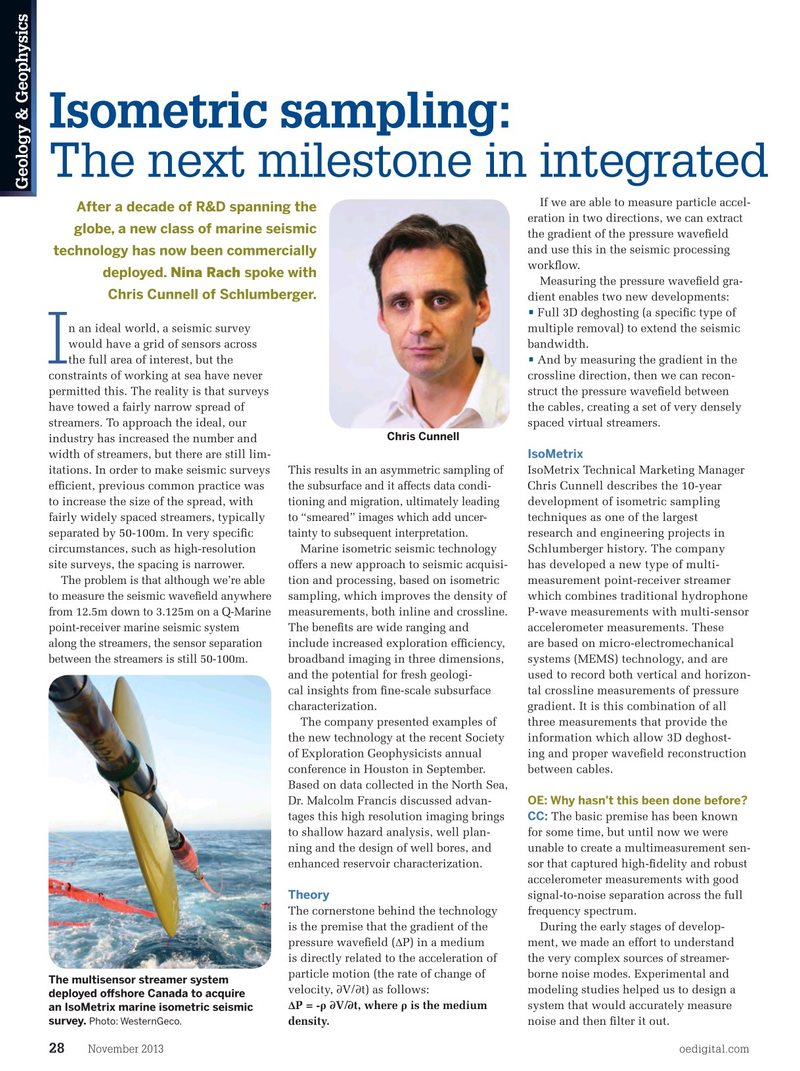
Page 26: of Offshore Engineer Magazine (Nov/Dec 2013)
Read this page in Pdf, Flash or Html5 edition of Nov/Dec 2013 Offshore Engineer Magazine
Isometric sampling:
The next milestone in integrated
Geology & Geophysics
If we are able to measure particle accel-
After a decade of R&D spanning the eration in two directions, we can extract globe, a new class of marine seismic the gradient of the pressure wavefeld and use this in the seismic processing technology has now been commercially workfow.
deployed. Nina Rach spoke with
Measuring the pressure wavefeld gra-
Chris Cunnell of Schlumberger.
dient enables two new developments: • Full 3D deghosting (a specifc type of n an ideal world, a seismic survey multiple removal) to extend the seismic would have a grid of sensors across bandwidth.
I the full area of interest, but the • And by measuring the gradient in the constraints of working at sea have never crossline direction, then we can recon- permitted this. The reality is that surveys struct the pressure wavefeld between have towed a fairly narrow spread of the cables, creating a set of very densely streamers. To approach the ideal, our spaced virtual streamers.
Chris Cunnell industry has increased the number and
IsoMetrix width of streamers, but there are still lim- itations. In order to make seismic surveys IsoMetrix Technical Marketing Manager
This results in an asymmetric sampling of effcient, previous common practice was Chris Cunnell describes the 10-year the subsurface and it affects data condi- tioning and migration, ultimately leading to increase the size of the spread, with development of isometric sampling to “smeared” images which add uncer- fairly widely spaced streamers, typically techniques as one of the largest tainty to subsequent interpretation.
separated by 50-100m. In very specifc research and engineering projects in circumstances, such as high-resolution Marine isometric seismic technology Schlumberger history. The company site surveys, the spacing is narrower. offers a new approach to seismic acquisi- has developed a new type of multi-
The problem is that although we’re able tion and processing, based on isometric measurement point-receiver streamer to measure the seismic wavefeld anywhere sampling, which improves the density of which combines traditional hydrophone from 12.5m down to 3.125m on a Q-Marine measurements, both inline and crossline. P-wave measurements with multi-sensor point-receiver marine seismic system
The benefts are wide ranging and accelerometer measurements. These along the streamers, the sensor separation include increased exploration effciency, are based on micro-electromechanical between the streamers is still 50-100m. broadband imaging in three dimensions, systems (MEMS) technology, and are and the potential for fresh geologi- used to record both vertical and horizon- cal insights from fne-scale subsurface tal crossline measurements of pressure characterization. gradient. It is this combination of all
The company presented examples of three measurements that provide the the new technology at the recent Society information which allow 3D deghost- of Exploration Geophysicists annual ing and proper wavefeld reconstruction conference in Houston in September. between cables.
Based on data collected in the North Sea,
Dr. Malcolm Francis discussed advan- OE: Why hasn’t this been done before?
tages this high resolution imaging brings CC: The basic premise has been known to shallow hazard analysis, well plan- for some time, but until now we were ning and the design of well bores, and unable to create a multimeasurement sen- enhanced reservoir characterization. sor that captured high-fdelity and robust accelerometer measurements with good
Theory signal-to-noise separation across the full
The cornerstone behind the technology frequency spectrum.
is the premise that the gradient of the During the early stages of develop- pressure wavefeld (?P) in a medium ment, we made an effort to understand is directly related to the acceleration of the very complex sources of streamer- particle motion (the rate of change of borne noise modes. Experimental and
The multisensor streamer system velocity, ?V/?t) as follows: modeling studies helped us to design a deployed ofshore Canada to acquire ?P = -? ?V/?t, where ? is the medium system that would accurately measure an IsoMetrix marine isometric seismic survey. Photo: WesternGeco.
density. noise and then flter it out.
November 2013 oedigital.com 28 028_OE1113_GG_SLBIsometrix2.indd 28 10/27/13 4:24 PM

 25
25

 27
27